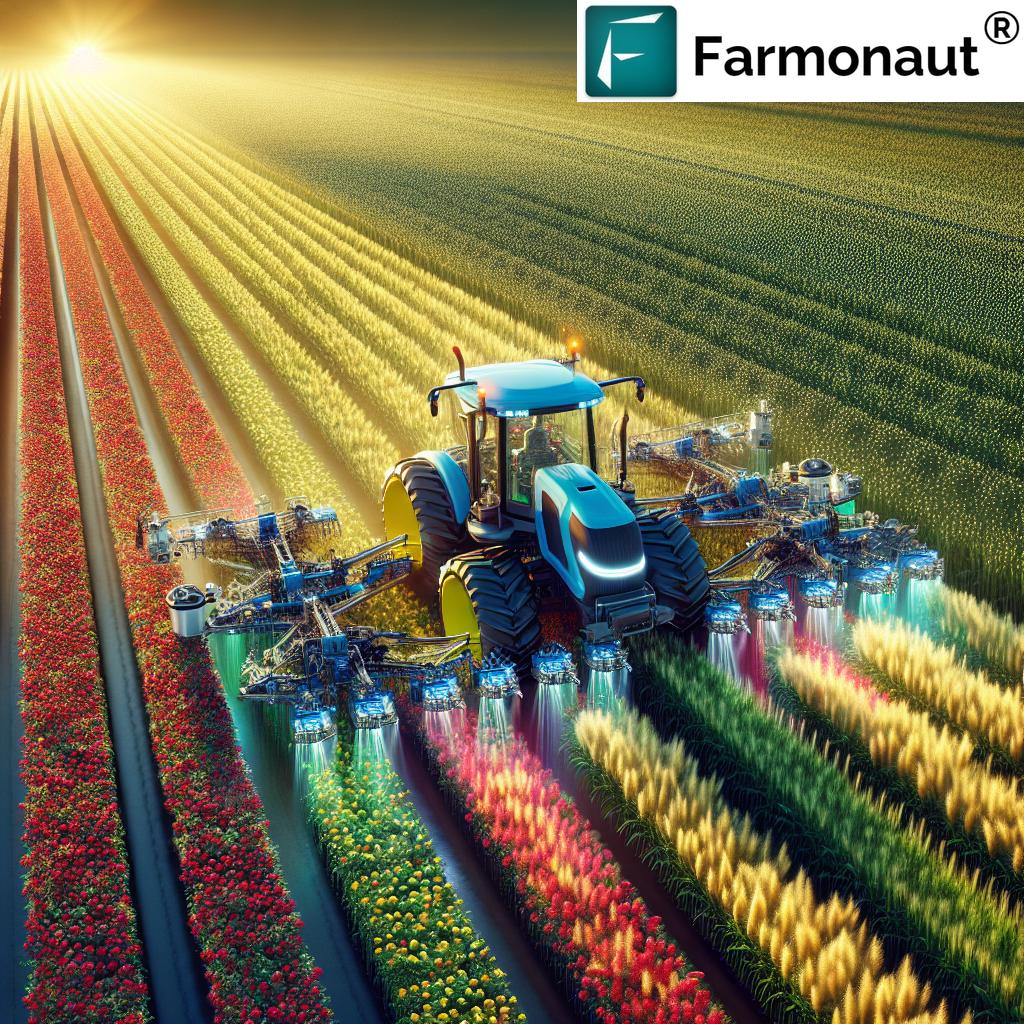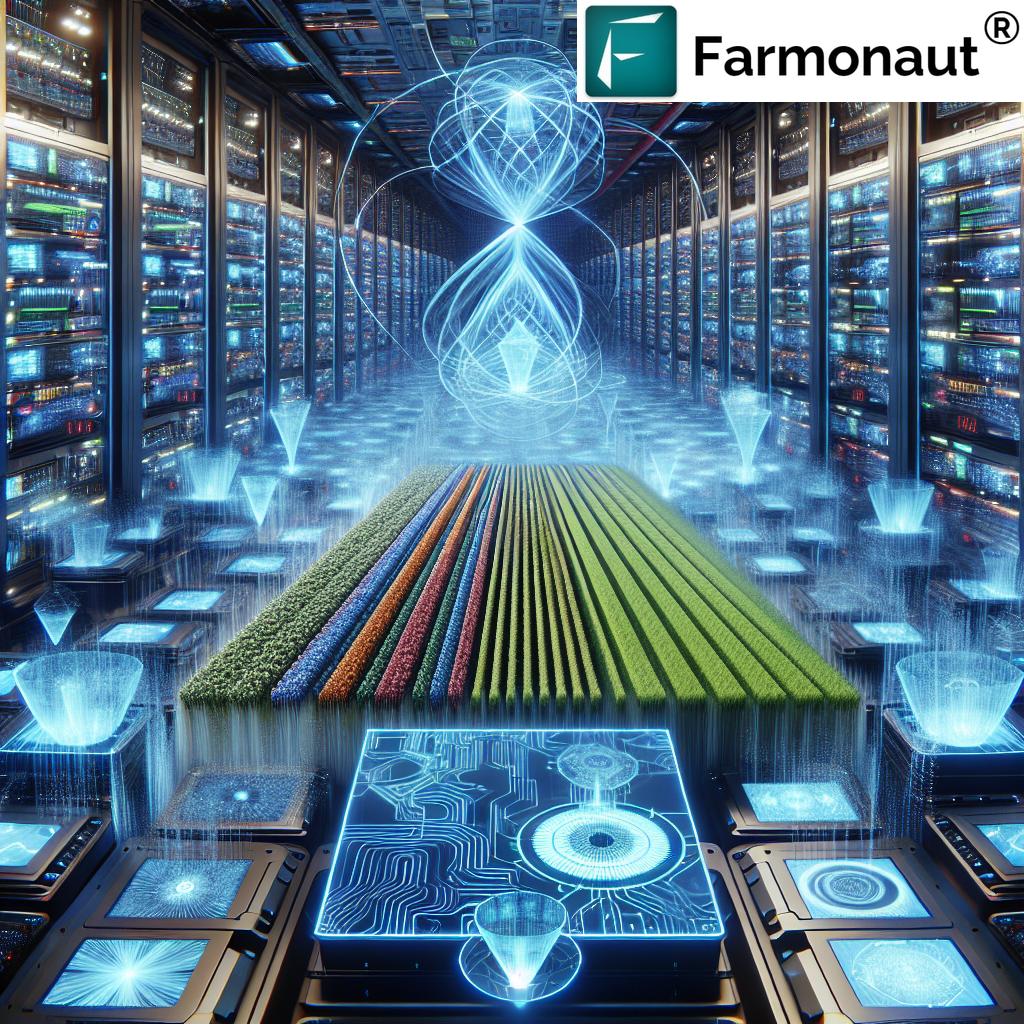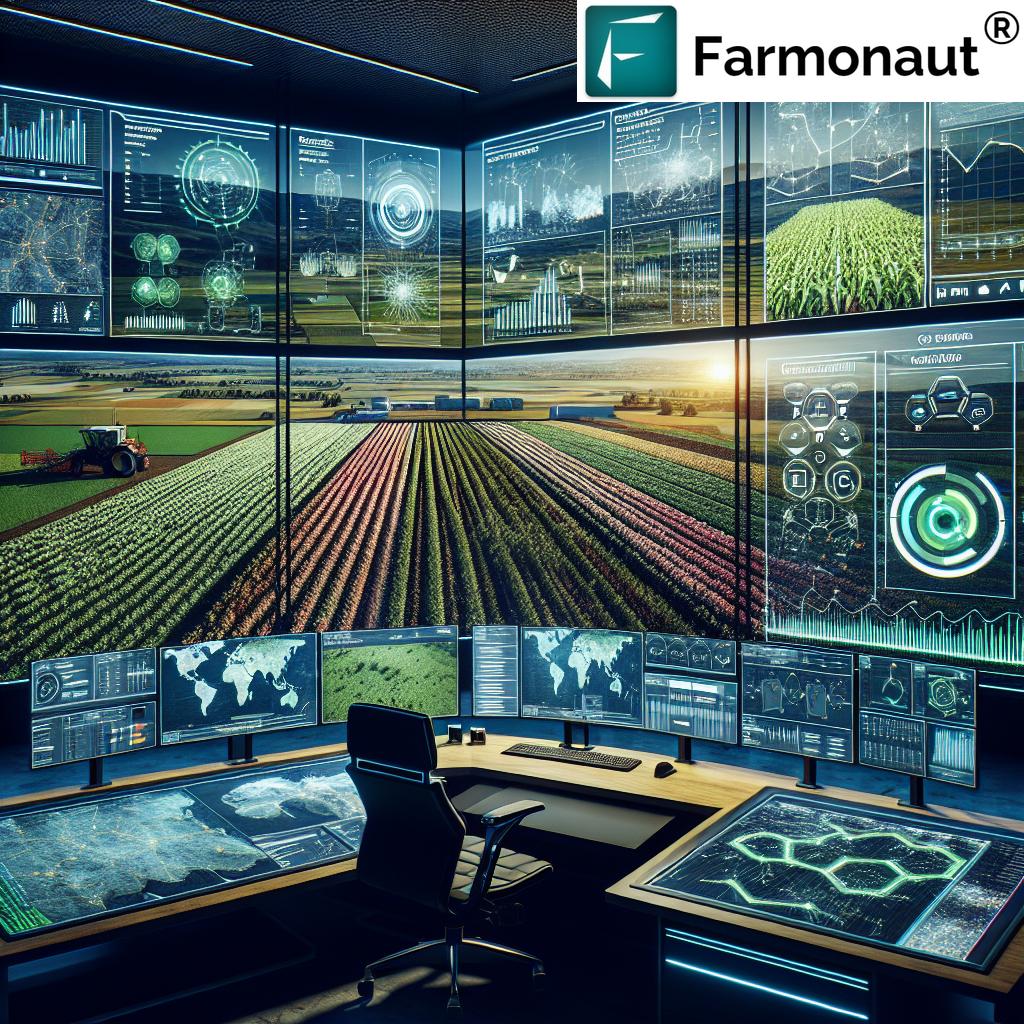7 Shocking Autonomous Farm Vehicles Transforming Agriculture
Table of Contents
- Introduction: The Age of Autonomous Farm Vehicles
- Types of Autonomous Farm Vehicles & Key Examples
- The 7 Shocking Autonomous Farm Vehicles
- Technological Components Driving Transformation
- Precision Agriculture Technology & Sustainable Farming Practices
- How Farmonaut Empowers Precision Agriculture
- Comparative Features Table of Top Autonomous Farm Vehicles
- Benefits Of Autonomous Farm Vehicles In Agriculture
- Challenges & Considerations: Scaling the Future
- The Future of Autonomous Vehicles in Farming
- FAQ: Autonomous Farm Vehicles and Precision Agriculture
- Farmonaut Subscription & Resources
Introduction: The Age of Autonomous Farm Vehicles
In recent years, we have witnessed a profound transformation in agriculture. As global food demand rises and labor shortages intensify, traditional farming methods are evolving rapidly. Enter the era of autonomous farm vehicles—a technological revolution powered by artificial intelligence (AI), machine learning, GPS, computer vision, advanced sensors, and data-driven systems.
From autonomous tractors plowing vast fields without drivers to robotic harvesters picking crops with surgical precision, these innovations are rewriting the rules of farming. Our quest for higher yield, sustainability, and greater efficiency depends on adopting these advanced farming tools.
In this blog, we explore how the marriage of autonomous technologies, AI in agriculture, and precision agriculture technology is boosting yield, minimizing resource usage, and paving the way for a greener, smarter future. Let’s navigate the landscape of these groundbreaking machines and see how they are changing agriculture for us all.
Types of Autonomous Farm Vehicles & Key Examples
Autonomous farm vehicles encompass a wide spectrum of machinery, each tailored to specific agricultural operations. Understanding the categories below helps us recognize the scope of their transformative power:
1. Autonomous Tractors
- Equipped with GPS, artificial intelligence, and computer vision, these tractors can handle plowing, tilling, planting, and harvesting—all without a human driver.
- Example: John Deere’s autonomous tractor. This revolutionary machine operates continually, monitored remotely via cameras and AI, addressing labor shortages and boosting operational efficiency.
2. Robotic Harvesters
- Designed for precision picking, robotic harvesters use advanced vision technologies and artificial intelligence for crops like fruits and vegetables.
- Example: FarmWise’s smart weeders—robots that can distinguish between crops and weeds, performing tasks like weeding efficiently and reducing the need for manual labor or chemical herbicides.
3. Autonomous Sprayers and Spreaders
- Sprayers and spreaders apply pesticides, fertilizers, and herbicides in a controlled, targeted manner, guided by AI and GPS.
- Example: Guardian Agriculture’s SC1 eVTOL aircraft—an unmanned, electric vertical take-off and landing vehicle that can dust, spray, and spread fertilizer over large acreages efficiently, minimizing environmental impact and resource usage.
Comparative Features Table: 7 Cutting-Edge Autonomous Farm Vehicles
| Vehicle Name | Manufacturer | Primary Function | Key Technologies Used | Est. Yield Boost (%) | Sustainability Impact | Market Availability |
|---|---|---|---|---|---|---|
| Autonomous 8R Tractor | John Deere | Plowing, Planting, Harvesting | AI, Machine Learning, GPS, Cameras, Computer Vision | 15% | Reduces fuel & pesticide use by up to 30% | 2023 (North America) |
| SC1 eVTOL Crop Sprayer | Guardian Agriculture | Dusting, Pesticide, Fertilizer Application | Autonomous eVTOL, GPS, Sensors, AI | 12% | Uses 25% less chemical inputs | 2024 (USA) |
| Dinabot Robotic Weeder | FarmWise | Weeding, Crop Care | AI, Machine Vision, Edge Computing | 10-14% | Eliminates chemical herbicides | 2022 (USA, EU) |
| AgBot Gen6 Cattle Feeder | AgroIntelli | Feed Distribution | LiDAR, Sensor Fusion, AI | N/A | Reduces feed waste by 20% | 2024 (Europe) |
| Fendt Xaver Swarmbot | AGCO/Fendt | Micro-Planting, Seeding | Swarm Robotics, AI, GPS | 10% | Minimizes soil compaction, boosts biodiversity | 2023 (EU Pilots) |
| Naïo Oz Fruit Harvester | Naïo Technologies | Harvesting, Weeding | Computer Vision, Autonomous Navigation | 13% | Lowers labor & water waste | 2023 (EU/USA) |
| Greenbot Sprayer Fleet | Precision Makers | Spraying, Spreading | Autonomous Vehicle Stack, GPS, AI | 9% | Reduces chemical runoff by up to 18% | 2021 (EU) |
The 7 Shocking Autonomous Farm Vehicles Leading the Revolution
Let’s take an in-depth look at these seven next-generation autonomous farm machines—technological marvels that epitomize progress in AI in agriculture and precision agriculture technology. Each one demonstrates the dramatic impact of automation, GPS-guided precision, and sustainable design on modern farming:
-
John Deere Autonomous 8R Tractor – The Flagship Autonomous Tractor
This fully autonomous tractor is loaded with GPS, six pairs of stereo cameras, AI decision-making, and real-time computer vision. Capable of handling plowing, tilling, sowing, and harvesting—all remotely managed—it sets the benchmark for labor efficiency, consistency, and safety in modern agriculture. With GPS guided farming equipment like this, each inch of the field is precisely worked, maximizing yield and minimizing chemical overlap and fuel consumption.
-
Guardian Agriculture SC1 eVTOL Crop Sprayer – Revolutionary Aerial Spraying
This electric vertical take-off and landing (eVTOL) aircraft brings crop dusting to a new level. With a 200-pound payload, autonomous operation, and the ability to cover 60 acres per hour, it exemplifies efficient, automated crop spraying. Precision application of fertilizers and pesticides means less chemical waste, reduced environmental impact, and healthier crops.
-
FarmWise Dinabot – Smart Robotic Weeding
Relying on AI, advanced sensors, and computer vision in agriculture, this robot identifies weeds from crops and mechanically removes them without chemicals. The Dinabot not only alleviates labor shortages but also avoids herbicide-resistant weeds, keeping soils and crops safer and more productive.
-
AgroIntelli Robotti – Modular Autonomous Power Platform
This highly flexible, robot-tractor platform supports a wide array of tasks—seeding, cultivation, spraying, and more—fueled by AI, GPS, and modular tool integration. Because it can work tirelessly (day or night), Robotti is ideal for high-precision, sustainable farm management and even reduces compaction through its lightweight, autonomous design.
-
Fendt Xaver Swarmbot – Swarm Planting Precision
The Xaver system turns sowing into a high-tech swarm operation. Dozens of small autonomous planters (“swarmbots”) work together, all orchestrated by AI and GPS, to execute micro-planting patterns perfectly, reducing input waste and optimizing field coverage.
-
Naïo Oz Harvester – Versatile Field Robot
With sophisticated computer vision, obstacle detection, and GPS-guided navigation, this small robot can weed, hoe, and even help with fruit harvesting. Designed for specialty and high-value crops, Oz empowers sustainable agriculture by lowering chemical and labor requirements.
-
Greenbot Autonomous Sprayer Fleet – Collaborative, Chemical-Saving Spraying
This fleet of compact, autonomous sprayers operates in perfect harmony, leveraging GPS, wireless communications, and computer-controlled distribution for fertilizers and pesticides. The result: dramatic reductions in chemical runoff and optimized resource application across large-scale agricultural enterprises.
Technological Components Driving Transformation
What enables these autonomous farm vehicles to outpace traditional farm machinery? It’s the meticulous integration of key technologies, each playing a critical part in field operations, safety, and efficiency:
- Sensors and Cameras: These devices give vehicles the “sense” to see and navigate. High-definition cameras combined with LiDAR, ultrasonic, and infrared sensors scan the environment for crops, obstacles, people, and livestock. For example, John Deere’s autonomous tractors use multiple camera arrays and computer vision to ensure safe, accurate driverless operations.
- Artificial Intelligence and Machine Learning: At the heart of autonomous agriculture systems, AI and ML algorithms interpret data from sensors, adapt to complex environments (like fields with irregular boundaries), and distinguish between crops and weeds—essential for targeting weeds or mapping optimal planting patterns.
- GPS-Based Navigation: With sub-inch accuracy, today’s GPS guided farming equipment executes precise field passes, minimizes crop overlaps, and enables automated headland turns. Modern autonomous tractors and sprayers rely heavily on GPS for consistency, saving time and reducing waste.
- Real-Time Edge Computing: In-vehicle computing systems perform split-second analysis and decision-making, reducing latency and empowering autonomous operations at field edge, even in low-connectivity areas.
- Fleet Connectivity and Cloud Control: Connectivity to the cloud or on-farm networks allows seamless scheduling, data monitoring, and orchestrating multiple machines for maximum efficiency and coordination.
Precision Agriculture Technology & Sustainable Farming Practices
Precision agriculture technology and AI in agriculture have rapidly matured, revolutionizing our approach to resource management and environmental impact. Let’s see how these paradigms are implemented on modern autonomous farms:
- Targeted Application of Inputs: Smart sprayers vary the amounts of fertilizers, pesticides, and water based on real-time crop need, soil condition, or pest populations. This slashes chemical use, saves costs, and curbs environmental impact.
- Automated Crop Monitoring: With computer vision, drone sensors, and satellite analytics, fields can be monitored for crop stress, pest outbreaks, or weed presence—triggering immediate action by connected autonomous vehicles.
- Soil & Water Conservation: Technologies like automated irrigation and variable-rate nutrient delivery help conserve precious water and reduce nutrient runoff—crucial for sustainable farming practices.
- Reduced Carbon Footprint: When AI optimizes machinery movement, fuel, and chemical use, greenhouse gas emissions can be lowered dramatically. Systems like electric eVTOL sprayers further reduce fossil fuel reliance.
Learn how Farmonaut’s carbon footprinting tools help monitor, reduce, and report environmental impact for compliance and future sustainability:
Farmonaut Carbon Footprinting
How Farmonaut Empowers Precision Agriculture
While autonomous vehicles redefine physical farm management, Farmonaut empowers farmers globally with digital satellite-based management, AI-driven insights, and resource optimization—all crucial to leveraging automation effectively. Here’s what makes Farmonaut’s solutions a foundation for precision agriculture technology:
- Satellite-Based Crop Health Monitoring: Using up-to-date multispectral satellite imagery, Farmonaut offers real-time insights into crop health (NDVI), soil moisture, and vegetation vigor. Farmers can instantly adjust irrigation, fertilizer, or spraying schedules based on specific needs, reducing waste and maximizing yield.
- AI-Powered Jeevn Advisory System: A proprietary AI engine, Jeevn delivers actionable, personalized advice—weather alerts, irrigation timing, disease/pest management—integrating ground realities with artificial intelligence for farming.
-
Blockchain-Based Product Traceability: Ensures every step of a crop’s journey from field to table is securely recorded, enhancing supply chain transparency, trust, and sustainability compliance. Discover how product traceability benefits agribusiness:
Farmonaut Traceability - Fleet and Resource Management: Using Farmonaut’s resource management modules, operations teams monitor their entire fleet of tractors, spreaders, and harvesters through a single dashboard—minimizing downtime, optimizing routes, and ensuring all machinery is tracked 24/7. Explore the tools for better machine scheduling and vehicle safety at Farmonaut Fleet Management
- Carbon Emissions Monitoring: Track emissions, set reduction targets, and comply with new regulations, driving sustainable farming practices.
- Accessible on All Devices: Whether you’re using Android, iOS, web, or integrating with custom apps via API, Farmonaut makes the latest precision agriculture technology affordable and easy.
Agribusinesses, governments, cooperatives, and individual farms all benefit, regardless of size. Farmonaut is available in flexible packages—including a powerful API for enterprise integration.
Explore the API here: Farmonaut API (Developer Docs)
For those focused on large-scale farm management, Farmonaut provides robust software interfaces to scale up operations and data-driven decision-making:
Farmonaut Agro Admin App
Farmonaut also supports key sectors with targeted solutions:
- Crop Loan & Insurance Verification: Satellite-based verification minimizes fraud and accelerates crop loan and insurance approval for banks and financial institutions. Crop Loan & Insurance Product Benefits
Benefits of Autonomous Farm Vehicles In Agriculture
- Labor Efficiency: Autonomous tractors and harvesters take over repetitive, strenuous fieldwork, allowing human workers to focus on complex managerial roles and addressing acute labor shortages.
- Precision and Consistency: Robotics and AI ensure every pass is executed with machine-level accuracy. This uniformity improves planting, fertilizing, and spraying, increasing both yield and crop quality.
- Resource Optimization: By varying input rates based on data, autonomous spreaders and sprayers reduce waste, driving lower costs per acre.
- Environmental Sustainability: Automated decision-making means only the necessary amount of chemical inputs are applied, cutting down runoff and enhancing sustainable farming practices.
- Timeliness and Reduced Downtime: Autonomous vehicles never tire or call in sick. They can work around the clock, ensure operations are on schedule, and respond instantly to weather or pest threats.
By helping farmers implement these practices, Farmonaut’s platform paves the way for more resilient, efficient, and environmentally conscious farming.
Challenges & Considerations: Scaling the Future
- High Initial Investment: The upfront costs of acquiring autonomous vehicles and supporting infrastructure (connectivity, sensors, software) can be prohibitive for small-scale farmers.
- Technical Complexities and Limitations: Operating in complex environments (e.g., orchards with narrow headlands or fields with irregular shapes) presents navigation challenges. For safe, efficient deployment, advanced obstacle detection, trajectory planning, and real-time feedback systems must be in place.
- Data Security & Privacy: With greater reliance on digital data and AI, protecting farm and operational data from breaches or misuse is vital. Robust cyber-security protocols are essential.
- Regulatory & Safety Compliance: Regulations surrounding the safe operation of autonomous vehicles, machine-pedestrian interaction, and chemical application must be rigorously observed and adapted to evolving technology.
Even as these hurdles are addressed by leading companies and agricultural technology providers, guidance and digital infrastructure (such as Farmonaut’s resource management ecosystem) are essential for safe, efficient adoption.
The Future of Autonomous Farm Vehicles and Precision Agriculture
With the rapid advancement of artificial intelligence for farming, robust computer vision and cheap sensors, the future of autonomous farm vehicles is bright:
- Increased Autonomy and Adaptability: Soon, fleets of robots will handle everything from soil preparation to harvest, with complete autonomy and real-time adaptation to weather, pests, and crop status.
- Wider Accessibility: As costs fall and flexible models (like Farmonaut’s subscription-based system) make digital farming affordable, even smallholders in India and Africa will access world-class precision agriculture.
- Integration with Digital Platforms: Field teams will monitor and coordinate their fleet through unified dashboards, leveraging AI-powered analytics and remote satellite management—making every farm a smart farm.
- Environmental Compliance and Reporting: With regular carbon reporting and traceability built in, tomorrow’s agriculture will be both productive and sustainable, compliant with evolving global standards.
The journey that started with automating tractors is leading us toward a fully autonomous, connected, and sustainable farming future!
FAQ: Autonomous Farm Vehicles, AI & Precision Tech in Agriculture
-
What are autonomous farm vehicles?
These are tractors, harvesters, sprayers, and other agricultural machines capable of operating with little or no direct human input, using AI, sensors, GPS, and computer vision for navigation and decision-making. -
How do autonomous tractors boost crop yield?
By performing repetitive tasks (like planting, spraying, and harvesting) with machine precision and optimizing inputs, they raise consistency, lower errors, and help achieve higher yields per acre. -
What technologies enable autonomous agriculture?
Key technologies include GPS, artificial intelligence, machine learning, sensors, computer vision, advanced cameras, and real-time data analytics platforms. -
Is precision agriculture technology only for large farms?
No. Thanks to cost-effective and scalable solutions from providers like Farmonaut, small and medium-sized farms can benefit as well, using just a smartphone or computer! -
How does Farmonaut support sustainable agriculture?
By offering real-time crop health monitoring, AI-based advisories, carbon footprint tracking, resource management, and blockchain-based traceability, Farmonaut enables data-driven, sustainable, and transparent farming operations. -
Can I integrate my own farm systems with Farmonaut’s data?
Yes. Through Farmonaut’s API and developer documentation, businesses and developers can seamlessly incorporate satellite and weather data into custom platforms. -
What is the best way to start with digital or precision farming?
Start small with satellite crop monitoring (via apps or web tools), integrate weather and AI-based advice, and scale up to automation as needed. Check out Farmonaut’s app for easy onboarding.
Get Started: Farmonaut Subscription Options
Whether you are a small farmer, large agribusiness, or technology developer, Farmonaut offers scalable subscription plans to give you the best of precision agriculture technology without the overhead of proprietary hardware. Plug in your fields, get instant analytics, and supercharge your farm’s efficiency, yield, and sustainability!
Conclusion
Autonomous farm vehicles—guided by AI, GPS, sensors, and digital intelligence—are not just a trend; they are the new backbone of sustainable, productive, and resilient agriculture.
From drones to tractors, spreaders to robotic harvesters, technology is closing the gap between soaring demand and shrinking resources, all while cutting labor costs and facilitating sustainable farming practices.
As the world moves forward, tools like Farmonaut’s suite of satellite-driven, AI-powered solutions will democratize access to cutting-edge precision agriculture technology, making it possible for every farmer, on every continent, to thrive.
Begin your journey today with Farmonaut’s affordable, accessible, and revolutionary digital farming platform.














